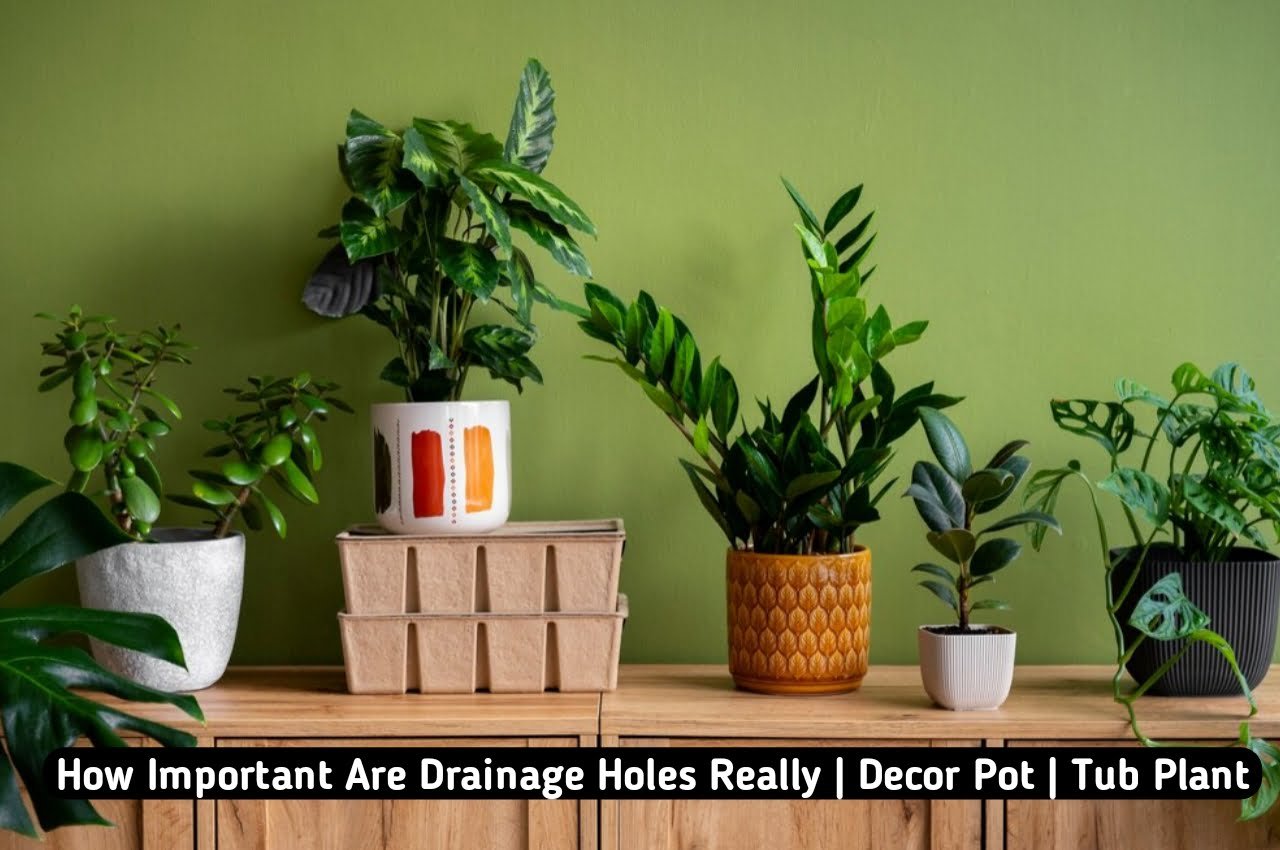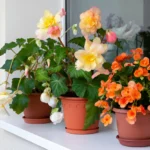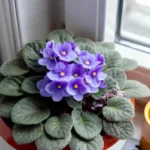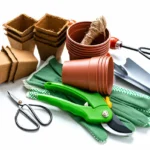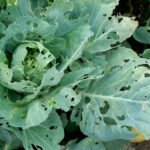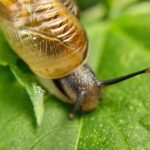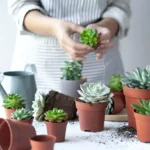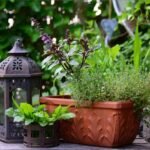When we look for pots in superstores, we look for aesthetic/decorative pots that will catch anyone’s eye. You may also be tempted to look at the pots when you take them in your hands and notice no hole in the bottom of the tub.
Are you confused that you will miss such a beautifully decorated pot? Can you take the tub without holes?
We will clarify your confusion. This article will discuss whether drilling a tub is important or unnecessary. Stay tuned.
Enthusiasm for plants is more noticeable among new gardeners, but cases of them killing trees due to excessive care are not uncommon.
As a new gardener, I used to water indoor plants daily. I watered the wet soil again.
More or less, we all enjoy watering the plants, too, and the plants used to die in this joy.
Newbies tend to do these things more. Excess water rots the roots and kills them.
Excess Water Escapes
The tendency to overwater is more noticeable among planters. It feels good to give water, so we have had the habit of providing water for a long time. But this habit can kill your favourite plant. When you water your plant, it holds the moisture in its soil and drains the excess through the holes in the bottom of the tub. That keeps your plant’s soil from getting wet and reduces the risk of the plant dying.
Air Circulation is Ensured
Plant roots and soil need aeration because plant roots breathe from the soil through the roots, and leaking the tub increases the amount of aeration in the plant’s soil. Leaks under the tub allow air and oxygen to circulate.
Repotting Time
The best part about plants is that they can provide transport when needed. But it is also essential for us to understand that plants grow in pots, and when their roots cannot fit inside the pot and become too rooted, they come out through holes at the bottom of the pot.
Because of the holes under the plant trunks, they can easily take nutrition. You can then understand that they are signalling you to report. It is best to report every 1-2 years, depending on average tree and plant growth.
The Soil is Not Wet
When watering the plants, excess water can escape due to the leak in the bottom of the tub. As a result, the soil of your plant does not stay wet. Wet soil causes mould to spread, and fertilizers in your soil lose effectiveness. Bacteria and fungi make a home in damp soil and damage plants.
Disadvantages of Having a Hole in the Pot
Water on the floor of the house. While having a hole in the bottom of the pot has advantages, it also has some disadvantages.
When you water your plants, it seeps through your drainage holes and collects on the floor of your house, making it look unsightly.
Collect the Water in the Tray and Return it to the Soil of the Pot.
If your plant pot has holes indoors, you must use a tray or plate under the pot to keep the room or house from getting dirty. When you are watering, you can sometimes see the plants slowly releasing Water, which collects in the tray and can be returned to the plant’s soil. That keeps your plant’s soil wet and increases the risk of root rot.
Larvae of Insects
Many of us are seen planting beautiful and bushy flowers or growing in beauty near the house door. The plants are placed at the house’s entrance and used as pots with holes, plates, and trays, which are seen to be used under pots. When Water accumulates in the tray outside, various insects, such as mosquitoes and flies, produce eggs and larvae in the Water, ruining your house’s environment.
Should I Make a Hole in the Pot of an Indoor Plant?
How much a plant parent is aware of their plants is more critical than watering them. A conscious plant lover would never kill his tree. He is more mindful and takes proper care of his plants. If you water the plant in the right amount, there is never any risk of root rot.
Many experienced and knowledgeable indoor gardeners plant in pots without holes and water when the soil dries out by testing it.
If you claim to be an experienced, knowledgeable, and sincere planter, you can plant in pots without drainage holes.
But if you are a newbie, plant in perforated pots. Try to maintain a watering routine, and when you learn which plants need to be watered every few days, you will be able to water them in the right amount.
Quality of Medium
Depending on your medium, plants tend to have waterlogging in the soil. You will create the proper nutrients and drainage medium for indoor plants. When you water your plants, the water will flow through the drainage holes. Excess water will not accumulate.
You make a soilless medium for indoor plants. Soil can hold water, keeping the medium moist. Plants use perlite, vermiculite, coco coir, gravel, etc. These materials keep the medium light and remove excess water that causes plant root rot.
Decorative Pot Can Be Used Without Piercing
You can plant indoor plants without cutting holes. But you shouldn’t put outdoor plants in pots without holes. I would highly recommend that you plant the plant in a perforated pot. We can control temperature, humidity, weather, light, and water indoors but not in outdoor pots or containers. Weather can turn nasty at any time. It might rain for days, and your outdoor potted plant may float in water (unless it has holes). Having holes will keep the soil of your plants moist but allow water to escape. No matter how big your plant is outside, plant it in a pot with holes.
If You Plant in a Pot That is Not Perforated, Why Does the Plant Die?
The plant will die if a tree is planted in a pot without a hole. When you water the plant without holes in the pot, excess water cannot escape. The soil is wet, and the air pockets in your plant’s soil will close due to it being wet. The plant roots receive oxygen from the air pockets in the soil and breathe. The roots cannot function properly. Due to the wetness of the plant soil, bacteria and fungi grow and express their activity in the soil. The soil smells and looks soggy, which is very bad. The roots fail to perform their functions, turn black, and eventually rot. Root rot will cause yellowing of leaves, browning of leaves, and wilting of stems. Eventually, it becomes difficult to save the tree.
How Do You Drill a Ceramic or Decorative Pot at Home?
If you’re an indoor gardener, you’ll be wondering how to enhance the beauty of your indoor pots. An aesthetic pot will make even your common plant 10 times more beautiful. You can find aesthetic decorative pots while searching in superstores or nursery stores that have been spinning in your head all day. However, looking at the pot in hand, you notice no hole! That can be pretty painful, but you have bought the pot. You can use a few minutes at home to pierce the decorative pots.
What You Will Need to Pierce Your Decorative Pot:
- The tripod hole for the 1/2′′ diamond was significantly expanded
- 1.2″ Glass/Tile bit
- Drill
- Water can or a small amount of water
- Marker pen
You must do the drilling, but you must take great care not to damage the pot of your choice while drilling.
Locate the hole point on the back of the tub (where you will make the hole). Keep a hole in the middle. Dot with a marker pen to mark the centre.
Now, attach the diamond tripod hole saw to the drill machine. Pour a small amount of water from the water can or the water I asked you to take on the marked part. That makes it easier to drill in slightly damp, wet areas.
After that, mark the part to be drilled by moving the drill head at a 45° angle in slow mode several times.
If the mark is clear, you can quickly run the drill. You will see that the hole is made. Pierce your beloved pot like this.
Watch the video shared for better understanding.
What Should I Use for Drainage Holes Before Putting Soil in the Pot?
Gardeners tend to put too much into the tub’s opening before adding soil. But I suggest you put mesh hole pads over the hole first. That prevents your soil from leaking through the pores. You can then use rocks, clay balls, aquarium pebbles, and broken pieces of clay pots (many gardeners use these).
But I will tell you to use LECA balls:
- L = Light
- E = Expanded
- C = Clay
- A = Aggregate
Do you know how leca is made? Then listen, the natural clay formed at high temperatures is called a LECA ball. They are lightweight, inorganic, have a neutral pH, and are fungus-free. You can easily use them as a drainage layer for your pot. Clay balls moisturize and air-balance the medium, which is excellent for your plants. Depending on the size of the pot, you should use a few inches of drainage.
Finally, you should use perforated pots indoors. If you are experienced, you can use non-perforated pots. However, it is highly recommended to make holes in outdoor pots.
